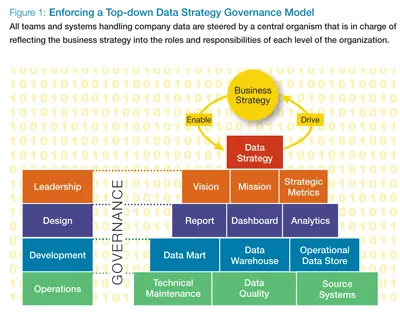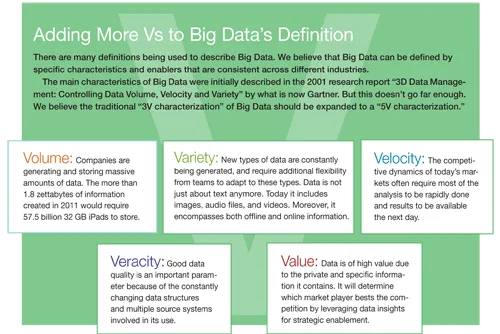There is no doubt that Big Data is at the forefront of executives' minds. They are, after all, being bombarded with information about the need to have a Big Data strategy, and some are making substantial investments to be as data savvy as possible. According to the Harvard Business Review, in 2011 alone companies invested more than $1 billion in Big Data. With so much at stake, C-level executives are under presssure to make the most of their data strategies.
Overall, there is a misconception created by the hype of Big Data. The fact that the term has been trending in the past few years has led some decision makers to believe that this is a new phenomenon that they need to tame in order to solve all their data problems. However, Big Data problems have existed for a long time, even before the term was coined. Data quality and systems capacity, for example, remain important issues that need to be understood by middle management and communicated to the C-suite in order to be properly addressed.
Further, there is an abundance of terms used interchangeably to describe Big Data and its utility in data-driven decision making. Big Data got added to the multiple terminologies that were already being referred to in the popular media such as analytics, predictive modeling, statistical analysis, data mining, and business intelligence, to name a few.
What's more, Big Data solutions tend to provide only part of the answer to the problem. There is no technology panacea for the issue of Big Data. Despite its complexities, C-level executives are aware that effective use of Big Data is extremely beneficial for an organization and can add immense value for smart decision-making. Yet there are three common strategic challenges faced by senior management:
Deriving insights: The first and biggest concern revolves around the challenge of gaining insights from Big Data. This is a legitimate challenge, since a lot of data is unstructured and in different formats, including text, photos, chat records, and social conversations. It poses an increasing challenge for organizations to capture and analyze it in order to derive actionable intelligence.
This challenge is intensified because business leaders need to glean insights from this onslaught of information and respond to it rapidly to differentiate themselves from the competition.
Bridging data silos: Many organizations grapple with data silos, where different departments collect their own data but stop short of sharing it with the rest of the business. The C-suite has an integral role in drawing up a strategy that ensures that different departments collaborate and integrate information from different channels to create a clearer picture.
This is not a simple task. Different departments within the same company often follow separate priorities, agendas, and methodologies in their daily operations. For example, the top priority for a data warehouse department might be upgrading one technical platform, thus shutting down all reporting capabilities for 24 hours, while the strategy department urgently needs to run ad-hoc analysis to pre-empt a new offering a competitor has just launched.
Seeing the big picture: Companies dealing with Big Data issues risk missing the forest for the trees. While organizations need to focus on various details, including technology, processes, and workforce to streamline their Big Data efforts, customer experience and satisfaction must remain the key targets. Therefore, executives need to ensure that overall customer satisfaction is not impacted and that Big Data efforts eventually converge to provide the customer with a better experience.
Addressing the C-Suite's concerns
These challenges are difficult, but not insurmountable. To address the above concerns effectively, C-level executives need to adopt a data strategy that mirrors the business strategy of the organization. An effective strategy will most importantly enforce a top-down governance that steers all efforts in a coherent manner toward a common goal. The data governance model should be put in place with clear roles and responsibilities and aligned with different stakeholders from diverse departments.

When going forward with the established data strategy, companies need to plan and execute actions in four main operational areas:
- Organization: It's crucial to focus on people when driving Big Data efforts. Teams will have to transition from a vertical approach where, for example, IT and business teams work independently from each other, to a horizontal mindset where alignment and regular collaboration lead both teams toward the same goal.
- Processes: Operational initiatives have to be set at an early stage of any Big Data effort in order to determine how different teams will communicate and coordinate together on project tasks and progress. All teams, whether from IT or business, have an important role to play in this process.
- Information: Leveraging Big Data should be accompanied by setting up monitoring KPIs in order to measure the consistency and completeness of the data that is newly available.
- Technology: Achieving Big Data success requires selecting specific technologies to be implemented in order to capture, process, and sense events at different levels\ of the organization.
We believe that the best approach consists of starting with the right assessment to determine the current situation and capabilities of the organization. This assessment leads to differentiated strategies, depending on the maturity of the company. One strategy could be building specialized data marts to serve immediate business needs, for example, whereas another strategy could include a fully fledged overhaul of existing environments.
There is no one common answer. Organizations have to arrive at a strategy based on their unique circumstances, industry, and most importantly, emerging customer needs and expectations. We believe that the best approach to plan and execute a Big Data strategy consists of starting with an assessment of the right capabilities and strategy to move forward. Once the strategy is decided, companies can involve the right consortium of expertise and partners in diverse areas of hardware, software, and consulting.


















